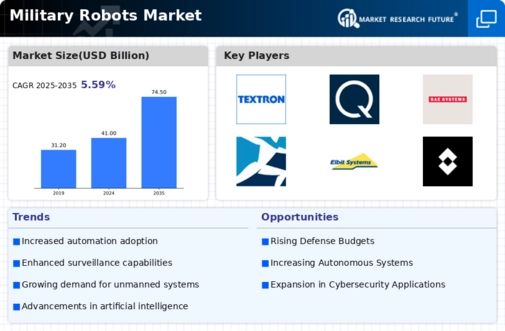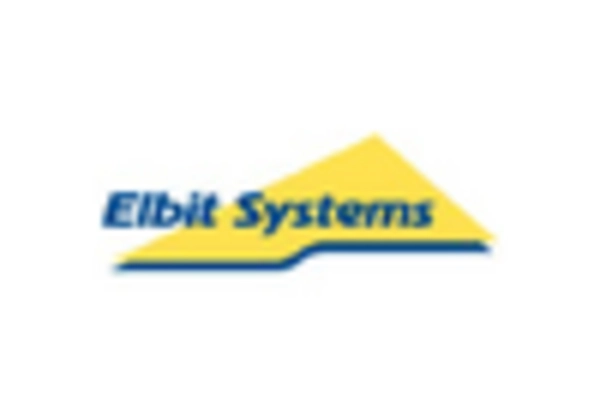Unmanned Ground Vehicles
Unmanned Aerial Vehicles
Unmanned Underwater Vehicles
Autonomous Combat Systems
Surveillance
Reconnaissance
Logistics Support
Explosive Ordnance Disposal
Teleoperated
Autonomous
Semi-Autonomous
Defense
Security
Research
North America
Europe
South America
Asia Pacific
Middle East and Africa
North America Outlook (USD Billion, 2019-2035)
North America Military Robots Market by Type
Unmanned Ground Vehicles
Unmanned Aerial Vehicles
Unmanned Underwater Vehicles
Autonomous Combat Systems
North America Military Robots Market by Application Type
Surveillance
Reconnaissance
Logistics Support
Explosive Ordnance Disposal
North America Military Robots Market by Technology Type
Teleoperated
Autonomous
Semi-Autonomous
North America Military Robots Market by End Use Type
Defense
Security
Research
North America Military Robots Market by Regional Type
US
Canada
US Outlook (USD Billion, 2019-2035)
US Military Robots Market by Type
Unmanned Ground Vehicles
Unmanned Aerial Vehicles
Unmanned Underwater Vehicles
Autonomous Combat Systems
US Military Robots Market by Application Type
Surveillance
Reconnaissance
Logistics Support
Explosive Ordnance Disposal
US Military Robots Market by Technology Type
Teleoperated
Autonomous
Semi-Autonomous
US Military Robots Market by End Use Type
Defense
Security
Research
CANADA Outlook (USD Billion, 2019-2035)
CANADA Military Robots Market by Type
Unmanned Ground Vehicles
Unmanned Aerial Vehicles
Unmanned Underwater Vehicles
Autonomous Combat Systems
CANADA Military Robots Market by Application Type
Surveillance
Reconnaissance
Logistics Support
Explosive Ordnance Disposal
CANADA Military Robots Market by Technology Type
Teleoperated
Autonomous
Semi-Autonomous
CANADA Military Robots Market by End Use Type
Defense
Security
Research
Europe Outlook (USD Billion, 2019-2035)
Europe Military Robots Market by Type
Unmanned Ground Vehicles
Unmanned Aerial Vehicles
Unmanned Underwater Vehicles
Autonomous Combat Systems
Europe Military Robots Market by Application Type
Surveillance
Reconnaissance
Logistics Support
Explosive Ordnance Disposal
Europe Military Robots Market by Technology Type
Teleoperated
Autonomous
Semi-Autonomous
Europe Military Robots Market by End Use Type
Defense
Security
Research
Europe Military Robots Market by Regional Type
Germany
UK
France
Russia
Italy
Spain
Rest of Europe
GERMANY Outlook (USD Billion, 2019-2035)
GERMANY Military Robots Market by Type
Unmanned Ground Vehicles
Unmanned Aerial Vehicles
Unmanned Underwater Vehicles
Autonomous Combat Systems
GERMANY Military Robots Market by Application Type
Surveillance
Reconnaissance
Logistics Support
Explosive Ordnance Disposal
GERMANY Military Robots Market by Technology Type
Teleoperated
Autonomous
Semi-Autonomous
GERMANY Military Robots Market by End Use Type
Defense
Security
Research
UK Outlook (USD Billion, 2019-2035)
UK Military Robots Market by Type
Unmanned Ground Vehicles
Unmanned Aerial Vehicles
Unmanned Underwater Vehicles
Autonomous Combat Systems
UK Military Robots Market by Application Type
Surveillance
Reconnaissance
Logistics Support
Explosive Ordnance Disposal
UK Military Robots Market by Technology Type
Teleoperated
Autonomous
Semi-Autonomous
UK Military Robots Market by End Use Type
Defense
Security
Research
FRANCE Outlook (USD Billion, 2019-2035)
FRANCE Military Robots Market by Type
Unmanned Ground Vehicles
Unmanned Aerial Vehicles
Unmanned Underwater Vehicles
Autonomous Combat Systems
FRANCE Military Robots Market by Application Type
Surveillance
Reconnaissance
Logistics Support
Explosive Ordnance Disposal
FRANCE Military Robots Market by Technology Type
Teleoperated
Autonomous
Semi-Autonomous
FRANCE Military Robots Market by End Use Type
Defense
Security
Research
RUSSIA Outlook (USD Billion, 2019-2035)
RUSSIA Military Robots Market by Type
Unmanned Ground Vehicles
Unmanned Aerial Vehicles
Unmanned Underwater Vehicles
Autonomous Combat Systems
RUSSIA Military Robots Market by Application Type
Surveillance
Reconnaissance
Logistics Support
Explosive Ordnance Disposal
RUSSIA Military Robots Market by Technology Type
Teleoperated
Autonomous
Semi-Autonomous
RUSSIA Military Robots Market by End Use Type
Defense
Security
Research
ITALY Outlook (USD Billion, 2019-2035)
ITALY Military Robots Market by Type
Unmanned Ground Vehicles
Unmanned Aerial Vehicles
Unmanned Underwater Vehicles
Autonomous Combat Systems
ITALY Military Robots Market by Application Type
Surveillance
Reconnaissance
Logistics Support
Explosive Ordnance Disposal
ITALY Military Robots Market by Technology Type
Teleoperated
Autonomous
Semi-Autonomous
ITALY Military Robots Market by End Use Type
Defense
Security
Research
SPAIN Outlook (USD Billion, 2019-2035)
SPAIN Military Robots Market by Type
Unmanned Ground Vehicles
Unmanned Aerial Vehicles
Unmanned Underwater Vehicles
Autonomous Combat Systems
SPAIN Military Robots Market by Application Type
Surveillance
Reconnaissance
Logistics Support
Explosive Ordnance Disposal
SPAIN Military Robots Market by Technology Type
Teleoperated
Autonomous
Semi-Autonomous
SPAIN Military Robots Market by End Use Type
Defense
Security
Research
REST OF EUROPE Outlook (USD Billion, 2019-2035)
REST OF EUROPE Military Robots Market by Type
Unmanned Ground Vehicles
Unmanned Aerial Vehicles
Unmanned Underwater Vehicles
Autonomous Combat Systems
REST OF EUROPE Military Robots Market by Application Type
Surveillance
Reconnaissance
Logistics Support
Explosive Ordnance Disposal
REST OF EUROPE Military Robots Market by Technology Type
Teleoperated
Autonomous
Semi-Autonomous
REST OF EUROPE Military Robots Market by End Use Type
Defense
Security
Research
APAC Outlook (USD Billion, 2019-2035)
APAC Military Robots Market by Type
Unmanned Ground Vehicles
Unmanned Aerial Vehicles
Unmanned Underwater Vehicles
Autonomous Combat Systems
APAC Military Robots Market by Application Type
Surveillance
Reconnaissance
Logistics Support
Explosive Ordnance Disposal
APAC Military Robots Market by Technology Type
Teleoperated
Autonomous
Semi-Autonomous
APAC Military Robots Market by End Use Type
Defense
Security
Research
APAC Military Robots Market by Regional Type
China
India
Japan
South Korea
Malaysia
Thailand
Indonesia
Rest of APAC
CHINA Outlook (USD Billion, 2019-2035)
CHINA Military Robots Market by Type
Unmanned Ground Vehicles
Unmanned Aerial Vehicles
Unmanned Underwater Vehicles
Autonomous Combat Systems
CHINA Military Robots Market by Application Type
Surveillance
Reconnaissance
Logistics Support
Explosive Ordnance Disposal
CHINA Military Robots Market by Technology Type
Teleoperated
Autonomous
Semi-Autonomous
CHINA Military Robots Market by End Use Type
Defense
Security
Research
INDIA Outlook (USD Billion, 2019-2035)
INDIA Military Robots Market by Type
Unmanned Ground Vehicles
Unmanned Aerial Vehicles
Unmanned Underwater Vehicles
Autonomous Combat Systems
INDIA Military Robots Market by Application Type
Surveillance
Reconnaissance
Logistics Support
Explosive Ordnance Disposal
INDIA Military Robots Market by Technology Type
Teleoperated
Autonomous
Semi-Autonomous
INDIA Military Robots Market by End Use Type
Defense
Security
Research
JAPAN Outlook (USD Billion, 2019-2035)
JAPAN Military Robots Market by Type
Unmanned Ground Vehicles
Unmanned Aerial Vehicles
Unmanned Underwater Vehicles
Autonomous Combat Systems
JAPAN Military Robots Market by Application Type
Surveillance
Reconnaissance
Logistics Support
Explosive Ordnance Disposal
JAPAN Military Robots Market by Technology Type
Teleoperated
Autonomous
Semi-Autonomous
JAPAN Military Robots Market by End Use Type
Defense
Security
Research
SOUTH KOREA Outlook (USD Billion, 2019-2035)
SOUTH KOREA Military Robots Market by Type
Unmanned Ground Vehicles
Unmanned Aerial Vehicles
Unmanned Underwater Vehicles
Autonomous Combat Systems
SOUTH KOREA Military Robots Market by Application Type
Surveillance
Reconnaissance
Logistics Support
Explosive Ordnance Disposal
SOUTH KOREA Military Robots Market by Technology Type
Teleoperated
Autonomous
Semi-Autonomous
SOUTH KOREA Military Robots Market by End Use Type
Defense
Security
Research
MALAYSIA Outlook (USD Billion, 2019-2035)
MALAYSIA Military Robots Market by Type
Unmanned Ground Vehicles
Unmanned Aerial Vehicles
Unmanned Underwater Vehicles
Autonomous Combat Systems
MALAYSIA Military Robots Market by Application Type
Surveillance
Reconnaissance
Logistics Support
Explosive Ordnance Disposal
MALAYSIA Military Robots Market by Technology Type
Teleoperated
Autonomous
Semi-Autonomous
MALAYSIA Military Robots Market by End Use Type
Defense
Security
Research
THAILAND Outlook (USD Billion, 2019-2035)
THAILAND Military Robots Market by Type
Unmanned Ground Vehicles
Unmanned Aerial Vehicles
Unmanned Underwater Vehicles
Autonomous Combat Systems
THAILAND Military Robots Market by Application Type
Surveillance
Reconnaissance
Logistics Support
Explosive Ordnance Disposal
THAILAND Military Robots Market by Technology Type
Teleoperated
Autonomous
Semi-Autonomous
THAILAND Military Robots Market by End Use Type
Defense
Security
Research
INDONESIA Outlook (USD Billion, 2019-2035)
INDONESIA Military Robots Market by Type
Unmanned Ground Vehicles
Unmanned Aerial Vehicles
Unmanned Underwater Vehicles
Autonomous Combat Systems
INDONESIA Military Robots Market by Application Type
Surveillance
Reconnaissance
Logistics Support
Explosive Ordnance Disposal
INDONESIA Military Robots Market by Technology Type
Teleoperated
Autonomous
Semi-Autonomous
INDONESIA Military Robots Market by End Use Type
Defense
Security
Research
REST OF APAC Outlook (USD Billion, 2019-2035)
REST OF APAC Military Robots Market by Type
Unmanned Ground Vehicles
Unmanned Aerial Vehicles
Unmanned Underwater Vehicles
Autonomous Combat Systems
REST OF APAC Military Robots Market by Application Type
Surveillance
Reconnaissance
Logistics Support
Explosive Ordnance Disposal
REST OF APAC Military Robots Market by Technology Type
Teleoperated
Autonomous
Semi-Autonomous
REST OF APAC Military Robots Market by End Use Type
Defense
Security
Research
South America Outlook (USD Billion, 2019-2035)
South America Military Robots Market by Type
Unmanned Ground Vehicles
Unmanned Aerial Vehicles
Unmanned Underwater Vehicles
Autonomous Combat Systems
South America Military Robots Market by Application Type
Surveillance
Reconnaissance
Logistics Support
Explosive Ordnance Disposal
South America Military Robots Market by Technology Type
Teleoperated
Autonomous
Semi-Autonomous
South America Military Robots Market by End Use Type
Defense
Security
Research
South America Military Robots Market by Regional Type
Brazil
Mexico
Argentina
Rest of South America
BRAZIL Outlook (USD Billion, 2019-2035)
BRAZIL Military Robots Market by Type
Unmanned Ground Vehicles
Unmanned Aerial Vehicles
Unmanned Underwater Vehicles
Autonomous Combat Systems
BRAZIL Military Robots Market by Application Type
Surveillance
Reconnaissance
Logistics Support
Explosive Ordnance Disposal
BRAZIL Military Robots Market by Technology Type
Teleoperated
Autonomous
Semi-Autonomous
BRAZIL Military Robots Market by End Use Type
Defense
Security
Research
MEXICO Outlook (USD Billion, 2019-2035)
MEXICO Military Robots Market by Type
Unmanned Ground Vehicles
Unmanned Aerial Vehicles
Unmanned Underwater Vehicles
Autonomous Combat Systems
MEXICO Military Robots Market by Application Type
Surveillance
Reconnaissance
Logistics Support
Explosive Ordnance Disposal
MEXICO Military Robots Market by Technology Type
Teleoperated
Autonomous
Semi-Autonomous
MEXICO Military Robots Market by End Use Type
Defense
Security
Research
ARGENTINA Outlook (USD Billion, 2019-2035)
ARGENTINA Military Robots Market by Type
Unmanned Ground Vehicles
Unmanned Aerial Vehicles
Unmanned Underwater Vehicles
Autonomous Combat Systems
ARGENTINA Military Robots Market by Application Type
Surveillance
Reconnaissance
Logistics Support
Explosive Ordnance Disposal
ARGENTINA Military Robots Market by Technology Type
Teleoperated
Autonomous
Semi-Autonomous
ARGENTINA Military Robots Market by End Use Type
Defense
Security
Research
REST OF SOUTH AMERICA Outlook (USD Billion, 2019-2035)
REST OF SOUTH AMERICA Military Robots Market by Type
Unmanned Ground Vehicles
Unmanned Aerial Vehicles
Unmanned Underwater Vehicles
Autonomous Combat Systems
REST OF SOUTH AMERICA Military Robots Market by Application Type
Surveillance
Reconnaissance
Logistics Support
Explosive Ordnance Disposal
REST OF SOUTH AMERICA Military Robots Market by Technology Type
Teleoperated
Autonomous
Semi-Autonomous
REST OF SOUTH AMERICA Military Robots Market by End Use Type
Defense
Security
Research
MEA Outlook (USD Billion, 2019-2035)
MEA Military Robots Market by Type
Unmanned Ground Vehicles
Unmanned Aerial Vehicles
Unmanned Underwater Vehicles
Autonomous Combat Systems
MEA Military Robots Market by Application Type
Surveillance
Reconnaissance
Logistics Support
Explosive Ordnance Disposal
MEA Military Robots Market by Technology Type
Teleoperated
Autonomous
Semi-Autonomous
MEA Military Robots Market by End Use Type
Defense
Security
Research
MEA Military Robots Market by Regional Type
GCC Countries
South Africa
Rest of MEA
GCC COUNTRIES Outlook (USD Billion, 2019-2035)
GCC COUNTRIES Military Robots Market by Type
Unmanned Ground Vehicles
Unmanned Aerial Vehicles
Unmanned Underwater Vehicles
Autonomous Combat Systems
GCC COUNTRIES Military Robots Market by Application Type
Surveillance
Reconnaissance
Logistics Support
Explosive Ordnance Disposal
GCC COUNTRIES Military Robots Market by Technology Type
Teleoperated
Autonomous
Semi-Autonomous
GCC COUNTRIES Military Robots Market by End Use Type
Defense
Security
Research
SOUTH AFRICA Outlook (USD Billion, 2019-2035)
SOUTH AFRICA Military Robots Market by Type
Unmanned Ground Vehicles
Unmanned Aerial Vehicles
Unmanned Underwater Vehicles
Autonomous Combat Systems
SOUTH AFRICA Military Robots Market by Application Type
Surveillance
Reconnaissance
Logistics Support
Explosive Ordnance Disposal
SOUTH AFRICA Military Robots Market by Technology Type
Teleoperated
Autonomous
Semi-Autonomous
SOUTH AFRICA Military Robots Market by End Use Type
Defense
Security
Research
REST OF MEA Outlook (USD Billion, 2019-2035)
REST OF MEA Military Robots Market by Type
Unmanned Ground Vehicles
Unmanned Aerial Vehicles
Unmanned Underwater Vehicles
Autonomous Combat Systems
REST OF MEA Military Robots Market by Application Type
Surveillance
Reconnaissance
Logistics Support
Explosive Ordnance Disposal
REST OF MEA Military Robots Market by Technology Type
Teleoperated
Autonomous
Semi-Autonomous
REST OF MEA Military Robots Market by End Use Type
Defense
Security
Research

















Leave a Comment